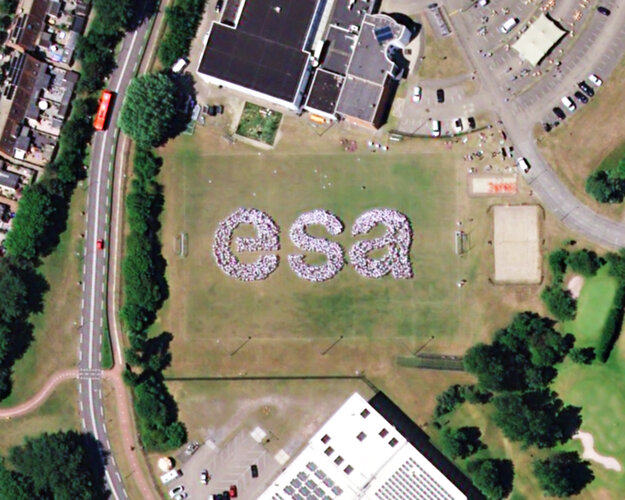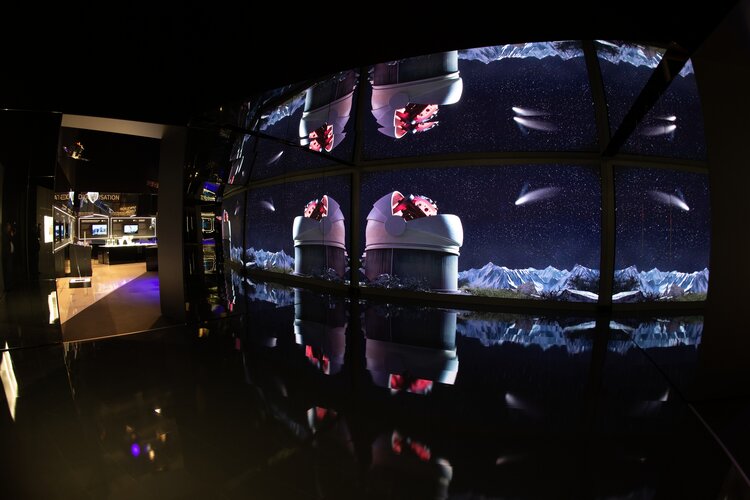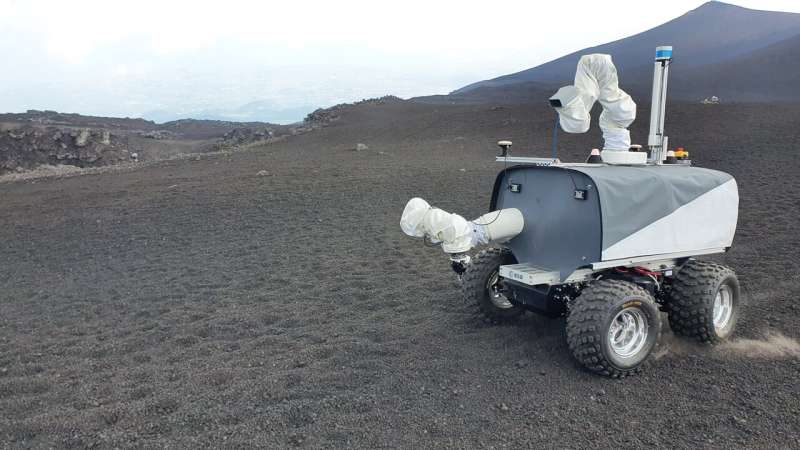Busek scales thruster production for Airbus OneWeb satellites
Friday, 24 June 2022 12:12 The in-space propulsion firm Busek Co. confirmed its supply of BHT-350 Hall effect thrusters for a range of missions supported by Airbus OneWeb Satellites (AOS). The Busek thrusters have been engineered and qualified to rigorous standards and are suitable for high-reliability, long-lifetime applications where thrusters are used for orbit raising, maintenance, and end-of-life de-orbit.
"We
The in-space propulsion firm Busek Co. confirmed its supply of BHT-350 Hall effect thrusters for a range of missions supported by Airbus OneWeb Satellites (AOS). The Busek thrusters have been engineered and qualified to rigorous standards and are suitable for high-reliability, long-lifetime applications where thrusters are used for orbit raising, maintenance, and end-of-life de-orbit.
"We BlackSky awarded Five-Year Joint Artificial Intelligence Center Contract for AI Data Readiness
Friday, 24 June 2022 12:12 BlackSky Technologies Inc. (NYSE: BKSY) was awarded a basic order agreement from the Joint Artificial Intelligence Center (JAIC) to create and optimize data sets for use in DoD AI models and applications. The JAIC agreement has a ceiling value of $241 million over five years.
"With demonstrated AI expertise in space-based dynamic monitoring, this agreement will open even more doors for Bla
BlackSky Technologies Inc. (NYSE: BKSY) was awarded a basic order agreement from the Joint Artificial Intelligence Center (JAIC) to create and optimize data sets for use in DoD AI models and applications. The JAIC agreement has a ceiling value of $241 million over five years.
"With demonstrated AI expertise in space-based dynamic monitoring, this agreement will open even more doors for Bla NASA Mars Orbiter Releasing One of Its Last Rainbow-Colored Maps
Friday, 24 June 2022 12:12 Scientists are about to get a new look at Mars, thanks to a multicolored 5.6-gigapixel map. Covering 86% of the Red Planet's surface, the map reveals the distribution of dozens of key minerals. By looking at mineral distribution, scientists can better understand Mars' watery past and can prioritize which regions need to be studied in more depth.
The first portions of this map were released
Scientists are about to get a new look at Mars, thanks to a multicolored 5.6-gigapixel map. Covering 86% of the Red Planet's surface, the map reveals the distribution of dozens of key minerals. By looking at mineral distribution, scientists can better understand Mars' watery past and can prioritize which regions need to be studied in more depth.
The first portions of this map were released Fine-grained rocks at Hogwallow Flats
Friday, 24 June 2022 12:12 Perseverance's exploration of the Hawksbill Gap area of the Jezero Delta continues! The rover has abraded at two different locations over the last few weeks. First, the rover abraded in the Devil's Tanyard area.
Unfortunately, the crumbly rocks at Devils Tanyard were broken and moved by the force of the abrasion. Nevertheless, the team was able to use the SuperCam and Mastcam-Z instruments
Perseverance's exploration of the Hawksbill Gap area of the Jezero Delta continues! The rover has abraded at two different locations over the last few weeks. First, the rover abraded in the Devil's Tanyard area.
Unfortunately, the crumbly rocks at Devils Tanyard were broken and moved by the force of the abrasion. Nevertheless, the team was able to use the SuperCam and Mastcam-Z instruments Drilling Again - Sols 3512-3513
Friday, 24 June 2022 12:12 Today was an exciting day of planning (and not just because of the thunderstorms here in southern California!). We planned a full drill of Avanavero, our first drill in over 6 months! The MAHLI image shows the spot after the DRT brush and our drill preload test.
In November 2021 we faced an anomaly with the brake mechanisms in the arm and out of an abundance of caution, the team decided to
Today was an exciting day of planning (and not just because of the thunderstorms here in southern California!). We planned a full drill of Avanavero, our first drill in over 6 months! The MAHLI image shows the spot after the DRT brush and our drill preload test.
In November 2021 we faced an anomaly with the brake mechanisms in the arm and out of an abundance of caution, the team decided to China launches new batch of remote sensing satellites
Friday, 24 June 2022 12:12 China successfully launched three new remote sensing satellites from the Xichang Satellite Launch Center in southwest China's Sichuan Province Thursday.
The satellites were launched as the second batch of the Yaogan-35 family at 10:22 a.m. (Beijing Time) by a Long March-2D carrier rocket and entered the planned orbit successfully.
The satellites will be mainly used to conduct science
China successfully launched three new remote sensing satellites from the Xichang Satellite Launch Center in southwest China's Sichuan Province Thursday.
The satellites were launched as the second batch of the Yaogan-35 family at 10:22 a.m. (Beijing Time) by a Long March-2D carrier rocket and entered the planned orbit successfully.
The satellites will be mainly used to conduct science A novel crystal structure sheds light on the dynamics of extrasolar planets
Friday, 24 June 2022 12:12 For decades, scientists have looked to the strange worlds beyond our solar system to understand more about our home planet. A team of researchers using the resources of the U.S. Department of Energy's (DOE) Argonne National Laboratory recently discovered more about those planets without leaving Earth.
More than 5,000 extrasolar planets have been discovered since 1992. These planets are lar
For decades, scientists have looked to the strange worlds beyond our solar system to understand more about our home planet. A team of researchers using the resources of the U.S. Department of Energy's (DOE) Argonne National Laboratory recently discovered more about those planets without leaving Earth.
More than 5,000 extrasolar planets have been discovered since 1992. These planets are lar How do you process space data and imagery in low earth orbit?
Friday, 24 June 2022 12:12 Aerospace organizations around the globe, including Axiom Space, are developing new ideas for how humans will explore, conduct research, and do business in low Earth orbit (LEO) when the International Space Station (ISS) is retired at the end of this decade. Regardless of what the next commercial space stations may look like, one thing is certain: humanity's desire for on-orbit scientific resear
Aerospace organizations around the globe, including Axiom Space, are developing new ideas for how humans will explore, conduct research, and do business in low Earth orbit (LEO) when the International Space Station (ISS) is retired at the end of this decade. Regardless of what the next commercial space stations may look like, one thing is certain: humanity's desire for on-orbit scientific resear Beyond Gravity launches its own start-up program "Launchpad"
Friday, 24 June 2022 12:12 The international space supplier Beyond Gravity is launching its own start-up program "Launchpad" in October 2022. The incubator supports young start-ups and their promising ideas around space technology.
In the process, teams are developed from an early stage to an initial investment opportunity. The application period runs until mid-August 2022.
From state-owned enterprise to start
The international space supplier Beyond Gravity is launching its own start-up program "Launchpad" in October 2022. The incubator supports young start-ups and their promising ideas around space technology.
In the process, teams are developed from an early stage to an initial investment opportunity. The application period runs until mid-August 2022.
From state-owned enterprise to start Chinese scientists help Africa combat land degradation
Friday, 24 June 2022 12:12 On June 16, the 28th World Day to Combat Desertification and Drought, China's national home event was held in Beijing, where Chinese scientists released an online tool, the Great Green Wall Big Data Facilitator, to help African countries combat increasingly severe land degradation.
Land degradation is one of the most significant global ecological and environmental challenges. Africa is par
On June 16, the 28th World Day to Combat Desertification and Drought, China's national home event was held in Beijing, where Chinese scientists released an online tool, the Great Green Wall Big Data Facilitator, to help African countries combat increasingly severe land degradation.
Land degradation is one of the most significant global ecological and environmental challenges. Africa is par MIT engineers devise a recipe for improving any autonomous robotic system
Friday, 24 June 2022 12:12 Autonomous robots have come a long way since the fastidious Roomba. In recent years, artificially intelligent systems have been deployed in self-driving cars, last-mile food delivery, restaurant service, patient screening, hospital cleaning, meal prep, building security, and warehouse packing.
Each of these robotic systems is a product of an ad hoc design process specific to that particula
Autonomous robots have come a long way since the fastidious Roomba. In recent years, artificially intelligent systems have been deployed in self-driving cars, last-mile food delivery, restaurant service, patient screening, hospital cleaning, meal prep, building security, and warehouse packing.
Each of these robotic systems is a product of an ad hoc design process specific to that particula Irvine scientists observe effects of heat in materials with atomic resolution
Friday, 24 June 2022 12:12 As electronic, thermoelectric and computer technologies have been miniaturized to nanometer scale, engineers have faced a challenge studying fundamental properties of the materials involved; in many cases, targets are too small to be observed with optical instruments.
Using cutting-edge electron microscopes and novel techniques, a team of researchers at the University of California, Irvine
As electronic, thermoelectric and computer technologies have been miniaturized to nanometer scale, engineers have faced a challenge studying fundamental properties of the materials involved; in many cases, targets are too small to be observed with optical instruments.
Using cutting-edge electron microscopes and novel techniques, a team of researchers at the University of California, Irvine Week in images: 20-24 June 2022
Friday, 24 June 2022 12:00
Week in images: 20-24 June 2022
Discover our week through the lens
ILA 2022 in images
Friday, 24 June 2022 11:32
Photo highlights from the ‘Space for Earth’ space pavilion at ILA, the Berlin Air and Space Show, from 22 to 26 .June 2022.
Image: Lunar science stirring on Mount Etna
Friday, 24 June 2022 11:23
This image comes to you from Mount Etna, Sicily, where a lunar analog study focusing on robotic exploration is currently unfolding.
The project—named the ARCHES Space-Analog Demonstration—is a multi-agency, multi-robot event brought to life by the German Aerospace Center DLR, and featuring significant ESA participation. ESA will be joining the project to run the latest and final part of the Analog-1 campaign, the completion of which will mark the culmination of one of the agency's long-term research endeavors, dating back to 2008.
For four weeks spanning 12 June to 9 July, the project will explore the operations and technologies that enable a sample return mission on the lunar surface involving an astronaut on the Lunar Gateway with a rover operations control room on Earth and scientific expertise on-hand at other control centers.
As part of the simulation, ESA astronaut Thomas Reiter will control a rover stationed 2,600 m up on the slopes of Mt. Etna from a room 23 km away in the nearby town of Catania. This distance simulates the sort of remote-control situations astronauts will encounter at the lunar Gateway.

